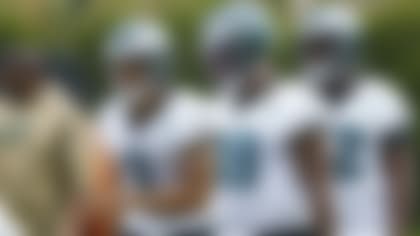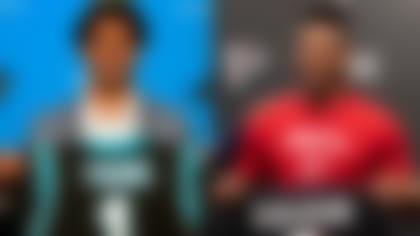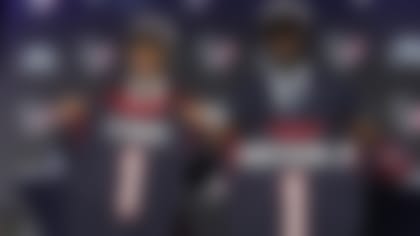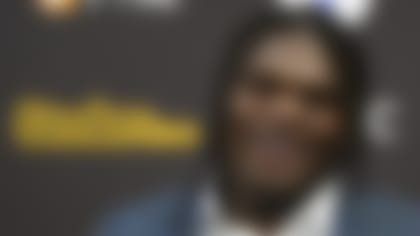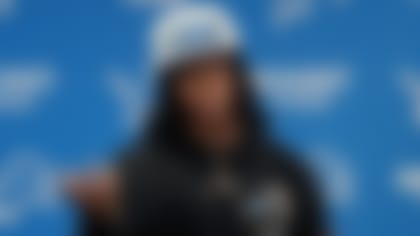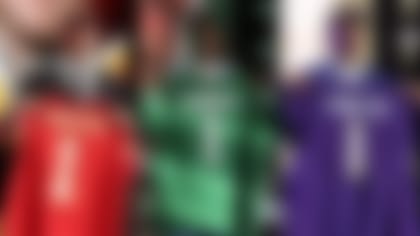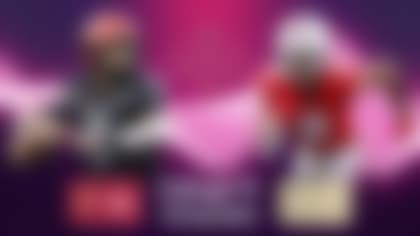NFL.com analysts Chad Reuter and Bucky Brooks handed out grades for every team following the 2012 NFL Draft. What follows is a look at the eight teams with the lowest draft grades (those sitting in the "C" and "D" range). Click the team name to see each team's entire class.
John Elway and John Fox have enjoyed an outstanding offseason with the addition of Peyton Manning, but the Broncos entered the draft with significant needs on both sides of the ball. The team nabbed Derek Wolfe in the second round after a series of trades with the New England Patriots and Tampa Bay Buccaneers. The hard-working defensive tackle is a Day 1 starter as a three-technique and immediately fills a Broncos' void along the defensive line. The additional pick gained from the flurry of trade activity netted Omar Bolden, an athletic corner recovering from a torn ACL that cost him his senior season. Offensively, the Broncos gambled on a franchise quarterback of the future in Brock Osweiler and also took a dynamic change-of-pace runner in Ronnie Hillman. The collective potential of the group could solidify the Broncos' future for years, but the series of strategic gambles on questionable prospects could also burn them.
Best pick: Derek Wolfe, DT, Cincinnati (Round 2, 36th overall pick).
As a blue-collar interior defender with size, strength and toughness, Wolfe fills a pressing need along the Broncos' defensive line.
Questionable pick: Brock Osweiler, QB, Arizona State (Round 2, 57).
The Broncos were willing to invest a high pick in an unproven quarterback prospect with only 15 career starts at Arizona State and a quirky throwing motion. Osweiler certainly shows intriguing potential, but taking a flier on a developmental quarterback prospect prevented the Broncos from addressing a more pressing need.
Sleeper pick: Ronnie Hillman, RB, San Diego State (Round 3, 67).
Hillman flew under the radar during most of the pre-draft process, but scouts view him as one of the most explosive change-of-pace backs in the draft. He brings a new dimension to the Broncos' backfield with his speed, quickness and receiving skills.
Rex Ryan is gambling on raw talent over production with the Jets' 2012 draft class. Quinton Coples and Stephen Hill are certainly two of the most impressive athletes in this draft, but neither guy played at an exceptional level during his final college season and that should raise red flags in war rooms. Although it is very possible that both players turn it around as pros, it is more likely they continue to rank as underachievers, based on their history.
Best pick: Quinton Coples, DE, North Carolina (Round 1, 16).
Yes, I expressed my concerns with this pick above, but Coples was considered by some to be a potential top-10 pick and could prove to be good value at No. 16. He's a naturally gifted defender capable of playing multiple spots along the front line.
Questionable pick: Stephen Hill, WR, Georgia Tech (Round 2, 43).
Hill's an enticing height/weight/speed prospect with upside, but he hasn't put it together yet.
Sleeper pick: Terrance Ganaway, RB, Baylor (Round 6, 202).
First-rounders Robert Griffin III and Kendall Wright weren't the only offensive weapons at Baylor. This hard-nosed runner has a nice combination of speed and power.
One of the league's biggest surprise teams in 2011 (13-3, NFC Championship Game appearance) won't sneak up on anyone this year. Jim Harbaugh will have his guys ready to play, though, and used the draft to plug some holes on the offensive line and at linebacker, despite picking near the end of every round. There are questions as to whether A.J. Jenkins was worth a first-round pick. He flashes a Mike Wallace-type game, but some scouts thought he was a carbon copy of Brandon Lloyd (who did not produce much in his first three professional seasons in San Francisco).
Best pick: Joe Looney, OG, Wake Forest (Round 4, 117).
His injury at the Senior Bowl was unfortunate, as it prevented teams from seeing his strength and versatility as a guard and center -- and also kept him from participating at the NFL Scouting Combine. But his physical nature and athleticism will allow him to challenge for a starting spot with the Niners in the near future.
Questionable pick: LaMichael James, RB, Oregon (Round 2, 61).
As I've mentioned with several of these "questionable" picks, James' listing here is not really about his talent level; his elite speed and quickness should make a good change-of-pace back in the NFL. But with Kendall Hunter already in the fold and other similar backs available later in the draft, the 49ers could have taken a cornerback, defensive end or linebacker who met more immediate needs.
Sleeper pick: Cam Johnson, OLB, Virginia (Round 7, 237).
The Niners simply needed more bodies at outside linebacker, so finding a possible down-the-road starter in the seventh round was a major bonus. Johnson looks like a prototypical 3-4 rusher, but he only had four sacks in 2011 and scouts question his consistency. He'll be a steal as a grass-eater off the edge if able to reach his potential.
Once again the Seahawks made a surprise first-round selection, picking West Virginia defensive end Bruce Irvin with the 15th overall pick one year after securing workmanlike offensive lineman James Carpenter at 25. They addressed a big need for a starting linebacker by selecting Bobby Wagner in the second round, found a reliable reserve quarterback in Wisconsin's Russell Wilson and added depth on defense with later picks accumulated in trades.
Best pick: Robert Turbin, RB, Utah State (Round 4, 106).
The second of two Aggies the Seahawks picked this year (along with Wagner), Turbin's value in the fourth round was too much to pass on, despite the team's signing of Marshawn Lynch to a four-year, $31 million contract in March. He can carry the mail a few times per game if Lynch is still hitting his stride, or be a reliable 20-carry back if Lynch is ever sidelined due to injury.
Questionable pick: Bruce Irvin, DE, West Virginia (Round 1, 15).
Irvin's ability as a pass rusher is well-documented, and the fact he had any success playing on a three-man front at 235 pounds is a tribute to his work ethic. He weighed 245 at the combine, but will need to prove himself either a capable every-down player in the 250-pound range or effective enough as a nickel rusher to warrant a top-15 selection (particularly when Melvin Ingram, Quinton Coples and Chandler Jones were still on the board). Staying out of trouble off the field will also help him win over doubters.
Sleeper pick: Jaye Howard, DT, Florida (Round 4, 114).
Howard flashed explosiveness as a penetrating three-technique and was moved outside at times due to his overall athleticism. If Seattle coaches can get him to play physical every snap, they'll have found a real bargain.
The 2011 draft-day trade that brought receiver Julio Jones to the Falcons added an impressive prospect to an already strong offense ... but robbed them of their first-round and fourth-round selections this spring. Filling their needs became difficult under these circumstances, but they ended up with a alright draft, finding good value on the offensive line with their first pick and adding some solid defensive prospects later on in safety Charles Mitchell (sixth round) and tackle Travian Robertson (seventh).
Best pick: Peter Konz, C/OG, Wisconsin (Round 2, 55th overall pick).
Because of the position he plays and some concerns about his quiet demeanor and ankle injuries, Konz fell into the Falcons' lap in the middle of the second round. The former Wisconsin center will play at right guard as a rookie while waiting to take over for veteran Todd McClure in the pivot.
Questionable pick: Lamar Holmes, OT, Southern Mississippi (Round 3, 91).
Holmes has potential because of his length and somewhat surprising athleticism, but he was picked a bit earlier than expected. His career will be compared to those of two more highly rated tackles selected after him: Bobby Massie and Brandon Mosley.
Sleeper pick: Jonathan Massaquoi, DE, Troy (Round 5, 164).
The two-time first-team All-Sun Belt pick had only six sacks in 2011 after racking up 13.5 sacks as a sophomore, yet still decided to enter the draft. Though only 6-foot-2, his ability to rush the passer and play with leverage on the edge made him a solid pick outside the top 150 overall selections.
It's hard to give an accurate assessment of the Raiders' efforts due to their limited number of picks, but Reggie McKenzie attempted to fortify the depth on his roster with this initial draft class. Tony Bergstrom is a big, physical road grader with the potential to crack the starting lineup at guard. Miles Burris, Jack Crawford and Juron Criner will fight for playing time as backups, and their speed and athleticism could make them valuable contributors on the Raiders' kicking units, too.
Best pick: Tony Bergstrom, OT, Utah (Round 3, 95).
As a big, physical blocker with a nasty demeanor, Bergstrom will add toughness to the Raiders' gritty offensive line. He will vie for a starting spot as a rookie and could be a long-term solution at a perennial problem area for the team.
Questionable pick: Miles Burris, OLB, San Diego State (Round 4, 129).
This is a tough category, considering the Raiders' lack of picks. Burris faces an uphill battle in grabbing a starting spot, but a role as a core special teamer is certainly not out of the question as a rookie.
Sleeper pick: Juron Criner, WR, Arizona (Round 5, 168).
Criner took a surprising plunge down the charts, despite a very productive career at Arizona. He is a big, physical pass catcher with sneaky speed and quickness. He could thrive as a No. 3 receiver for the Raiders.
New general manager Les Snead had his work cut out for him, taking over a roster devoid of playmakers. The lack of talent resulted in a lucky break for the new administration; the Washington Redskins handed over a second-round pick this year and first-rounders in 2013 and 2014 to swap 2012 first-rounders with St. Louis (so they could select quarterback Robert Griffin III). The Rams proceeded to trade down again on draft night (with the Cowboys, who took cornerback Morris Claiborne), gaining yet another second-round pick. But Snead took some risks with each of his top six picks, adding talented players with question marks about their off-field conduct and/or level of competition. Strong (but young) defensive tackle Michael Brockers was Snead's first draft pick with the team -- and could be the bellwether pick of the class, too.
Best pick: Janoris Jenkins, CB, North Alabama (Round 2, 39).
Jenkins' off-field concerns are the greatest of all the team's early picks -- but so is his talent. The man-cover skills he displayed at Florida before being dismissed for multiple marijuana-related offenses could give Snead a nice payoff for taking a chance in the top 40. If fellow corner Trumaine Johnson also reaches his potential, they'll form a tough duo outside.
Questionable pick: Brian Quick, WR, Appalachian State (Round 2, 33).
Jacksonville's trade-up in Round 1 cost the Rams a chance at top receiver prospect Justin Blackmon, so they grabbed a Quick solution with the first pick of the second round. He has an NFL frame (6-foot-3, 220), but his level of competition and ability to grasp NFL offenses were serious concerns for scouts. Even though it's unfair, Quick's career will always be compared to the bigger-named receivers picked after him: Stephen Hill, Alshon Jeffery and Rueben Randle.
Sleeper pick: Chris Givens, WR, Wake Forest (Round 4, 96).
If Quick doesn't work out, the team might have found a good insurance policy in Givens. He doesn't tower over defenders like Quick, but his 4.4 speed and solid hands make him a promising vertical threat. He must prove to his coaches that he's ready to do what is necessary to succeed, but if he does -- NFL defenses beware.
Having already given up their first-round pick in last year's draft-day trade for running back Mark Ingram, the Saints forfeited their second-round pick because of the bounty scandal. That made it difficult for the team to greatly improve its roster. Though New Orleans found a couple of intriguing prospects, it's tough to say it was even an average draft class.
Best pick: Akiem Hicks, DT, Regina (Round 3, 89).
If Hicks had ended up playing for LSU -- his intention before recruiting violations surfaced -- he might have become the star that Michael Brockers did in 2011. His combination of size (6-4 5/8, 315) and athleticism mitigates the risk some might say the Saints took by picking him near the end of the third round.
Questionable pick: Corey White, DB, Samford (Round 5, 162).
The Saints only had five picks, which limits the number of possibly "questionable" selections. White does have potential to become a contributor in the secondary, but they had a chance to get a pass rusher like Troy's Jonathan Massaquoi, who would have received a lot of playing time early with the four-game bounty suspension of defensive end Will Smith.
Sleeper pick: Nick Toon, WR, Wisconsin (Round 4, 122).
Maybe this should instead be called the "bargain pick," as Toon's availability in the fourth round wouldn't have been expected before last season. If able to get past his injury issues, though, he'll contribute heavily in the Saints' offense over the next few years.
Follow Bucky Brooks and Chad Reuter on Twitter @BuckyBrooks and @ChadReuter

